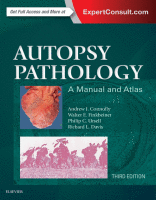Physical Address
304 North Cardinal St.
Dorchester Center, MA 02124

Outline ADULTS Table B-1: Adult organ weights and measures Table B-2: Percentage weight change of organs with formalin fixation Table B-3: Adult heart weight by body length Table B-4: Brain weight by age, 0-90 years FETAL Table B-5: Fetal body…

You’re Reading a Preview Become a Clinical Tree membership for Full access and enjoy Unlimited articles Become membership If you are a member. Log in here

* Florey HW. The history and scope of pathology. In: Florey L, ed. General pathology . Philadelphia: WB Saunders; 1970:1-21. External Findings Pericardial, Pleural, and Peritoneal Cavities Cardiovascular System Respiratory System Gastrointestinal System You’re Reading a Preview Become a Clinical…

Even in this high-technology era, the autopsy continues to play a prominent role in medical quality assurance and quality improvement, particularly in health care facilities that support educational or academic programs. Autopsies consistently identify misdiagnoses at a significant rate and…

Death certificates ( Fig. 14-1 ) serve two primary purposes: legal and statistical. Legally, death certificates contribute to the record of death and are commonly used in medicolegal, interment, insurance, and inheritance matters. Statistically, death certificates are widely used in…

Multiple organ dysfunction, either from infectious or noninfectious causes, has been increasing in incidence in hospitals in developed countries and is present in an increasing proportion of hospital-based autopsies. It is the most common cause of death in noncoronary critical…

The occurrence of sudden death presents a challenge to the general autopsy pathologist, who usually examines hospitalized patients with detailed medical records. In this chapter we discuss the approach to the patient who dies within 1 hour of the onset…

The autopsy report is a description and interpretation of the findings at necropsy and provides a record of the completed case as seen from the perspective of the anatomic pathologist. The document is part of the patient's medical record or,…

Collection of Samples The hospital autopsy pathologist should take full advantage of modern chemical, microbiologic, cytogenetic, and molecular analysis of body fluids, tissues, and cells as a supplement to anatomic dissection and microscopic examination if necessary. Careful review of the…

This chapter will present common or important microscopic findings seen in autopsies, with an emphasis on deaths that are from natural causes or are hospital based. It is not meant to be comprehensive, but it should provide a helpful adjunct…